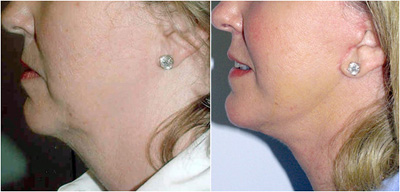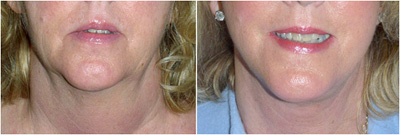Face Lifts
Face lift surgery
With the passage of time our cheeks begin to sag, jowls form, the neck sags, and the furrows around our mouth and lips get deeper which all together create a sad, tired look. A facelift can significantly reverse the signs of aging. There are multiple types of facelifts to choose from and the correct one for you will be based on your particular needs. OHSU Casey Aesthetic Facial Surgery Center's facelift expert, Dr. Roger Dailey will assist you in deciding whether the mid-face lift or lower-face lift, or perhaps both, is right for you. You owe it to yourself to investigate your options thoroughly and to meet with an expert to discuss your needs. "Mini" or short incision facelifts are also an option for many people with early jowling and neck changes.
Call 503 494-3004 to schedule your consultation with Dr. Dailey or to request additional information.
Facelift results
Although results vary, all of our patients have been happy to delighted with their new, more youthful and relaxed appearance. The goal of facelift surgery is to reduce wrinkles, sagging skin and lax jowls and to provide a younger more vibrant appearance. After that, the aging process still continues. Your lifestyle choices, bone structure, skin type, sun exposure and heredity all play a role in determining the results of facelift surgery and how long the results will last. In general younger patients enjoy longer-lasting results. If you are in your forties, the effects may beyond ten years. Adjunct procedures such as botox, fillers, and laser resurfacing can significantly improve the results and help to maintain them. Avoidance of smoking is key to avoid complications at the time of surgery and to maintain your results long after the procedure has been performed.


Mid-face lift surgery
The earliest signs of facial aging often appear in the mid-face area, that's the triangle area defined by the inner and outer corners of the eye and the corner of the mouth. The cheeks begin to drift downward which creates a prominent fold on the sides of your nose. You may be thinking you're not quite ready for a complete facelift, but you may be a perfect candidate for a mid-face lift. A mid-face lift can help reduce the wrinkles and give you fuller looking cheekbones, helping to regain your youthful look. This may be the best solution for individuals experiencing sagging cheeks and deep labial folds, but not having problems with sagging jowls.
Dr Dailey has mastered techniques, using invisible incisions inside the eyelids and or mouth to elevate the sagging cheeks, giving a more youthful appearance and seemingly higher cheek bones. Mid-face lifting surgery can be done in conjunction with lower eyelid surgery (blepharoplasty) as well as brow and lower face lifts. Soft tissue fillers can also help improve results remarkably.
Lower face lift surgery
Descent of the lower portion of the face causes the youthful shape of the face to take on more of a square configuration formed by the jowls. A lower facelift can elevate the jowls and reverse the early changes of aging of the lower portion of the face and neck.
Our expertise
Roger A. Dailey, M.D., F.A.C.S. has applied the concepts of general and microsurgery, which have made him an expert in eyelid, forehead and mid-face surgery, to correcting the aging changes that occur in the lower portion of the face. Using these innovative techniques, patients can actually recover from the lower facelift even more rapidly than they recover from cosmetic eyelid surgery, forehead, or mid-face surgery in some cases.
Facelift procedure
Facelift procedures are performed as an out-patient procedure at OHSU Casey Aesthetic Facial Surgery Center. The procedure is usually performed under general anesthesia with the patient asleep, but can be performed using a local anesthesia or “twilight anesthesia”. Incisions are made in the natural crease of the facial skin and begins inside the hairline, in the temple area above and forward of the ear. It continues inside the ear, or in front of the ear around the earlobe and behind the ear. The skin is redraped carefully into a more youthful position. Importantly, the surgeon tightens and repositions the underlying muscles and tissues so there is NO tension on the skin to avoid that “surgical look”. Excess skin and fat may be removed or repositioned. The incision is then closed with fine sutures and/or clips. A facelift can take between two to four hours depending on the extent of the procedure. "Mini" or short incision facelifts can also be performed in less time and with less expense in patients whose aging changes are more limited.
After surgery
There will be bruising and swelling that will persist for several few days. Pain is normally minimal and can be controlled with oral medication. Your bandages will be removed in our office a day or two after surgery. You can then take a shower and wash your hair. Sutures are removed in one to two weeks. Healing is a gradual process. After about two weeks you will feel comfortable (with make-up) among strangers. After three weeks you will look and feel confident enough to go out with friends again. Your face will usually feel “normal” in a few weeks. Direct sun should be avoided for several weeks.
Frequently asked questions (FAQ) about face lifts
The primary reason is to look younger and to have a happier expression on the face. With facial aging there is a descent or drooping of the cheeks and mid-face. The descent of the cheeks causes one to have a sad expression on the face. Descent of the cheek also contributes to dark circles under the eyes and to deepening of the fold between the cheek and lips (nasolabial fold). Elevation of the cheeks can reduce the dark circles and nasolabial fold while giving the patient a more cheerful expression.
The primary reason is to look more youthful. With facial aging there is descent of the lower portion of the face. This causes soft tissue to droop below the jaw line (jowls). When we are young, the jaw line is round with the soft tissue following the boney contour. Jowl formation changes the jaw line from a round configuration with the skin tightly associated to the bone, to a squared configuration with loose tissue hanging below the boney jaw line. A mini facelift surgery can elevate the jowls, and return the lower face to a youthful round contour.
There are several reasons. One reason is that the structures that attach the skin to the boney skull elongate allowing for sagging of the skin. A second reason is loss of elasticity of the skin so that the skin itself sags. A final important reason is loss of volume. Our face loses volume with time and this facilitates wrinkle formation and descent of the face. A common analogy is a beach ball. If the ball is fully inflated it will be perfectly round and without wrinkles on the surface. If some of the air is let out of the ball it will no longer be round and it develops wrinkles on the surface.
Aging causes both loss of volume and drooping of the cheeks and lower face
Most patients benefit from addressing both. We often perform face lift surgery, and add volume with fillers during the same procedure or at a later time. Adding volume with fillers often reduces the amount of surgery that is done and allows the patient to recover more rapidly.
Mid-facelift surgery is typically performed at the same time as eyelid surgery. Eyelid surgery results in bruising and swelling that often resolves within 3 weeks.
It takes 2-3 weeks for bruising and swelling to resolve for the most part. There can be significant variation between patients and those that tell us they heal well usually do and those that inform us that they heal slowly or bruise easily also generally do.
No. We usually perform the procedure in the surgery center using the anesthesia of the patient's choice. Patients are often less anxious with intravenous sedation and the switch to heavier anesthesia can always be made if necessary. Patients are often concerned that they might "wake up" and be uncomfortable. Our approach avoids that problem.
Some sutures dissolve on their own and others are removed at one to two weeks after the procedure.
The surgery technique used at the Casey Aesthetic Facial Surgery Center has little effect on the sideburns and hairline.
In some patients the primary problem is loss of volume from the face and there is not much sagging or drooping soft tissue. In these cases simply adding volume to the face with fillers can substantially improve the aging changes in the mid-face and to a lesser degree, the lower face. We now have fillers available that give results for a year or two and longer. Learn more about fillers.
Laser resurfacing can also prolong the need for surgical intervention.
Most bad facelift results are caused by removal of too much skin, poorly placed incisions, or lack of deep dissection and support. Removal of too much skin results in an unnatural, pulled back, windswept appearance. The amount of skin that must be removed to achieve an acceptable improvement in appearances is reduced if volume is added at the same time that the skin is removed. It is particularly important to avoid unnecessary removal of skin from the lower eyelids as this can cause problems with eyelid closure and vision. Deep musculoligamentous support of the skin takes any tension off it and allows for a natural looking result.
If jowl formation is the primary concern then the mini facelift is our procedure of choice. Some patients have excess skin in the neck as well as jowls. As long as the neck is thin and the amount of skin in the neck is mild to moderate our procedure of choice is still the mini facelift. If someone has a thick heavy neck with much redundant skin in the neck, then a neck lift is more beneficial than a mini facelift. A neck lift is sometimes called a full-facelift. A neck lift differs from a mini facelift as the incision extends much further behind the ear and the amount of surgery is greater in the neck lift. Most patients have a neck lift performed in a surgery center under general anesthesia. It can take somewhat longer to recover from a face and neck lift than a mini facelift alone.
Yes. Many patients prefer to get all procedures performed at the same time. This allows the patient to go through a single recovery period and is also more cost effective.
Yes. All medical procedures have risk associated with them. You should discuss the risk of facelift surgery with your surgeon so that you can make an informed decision.